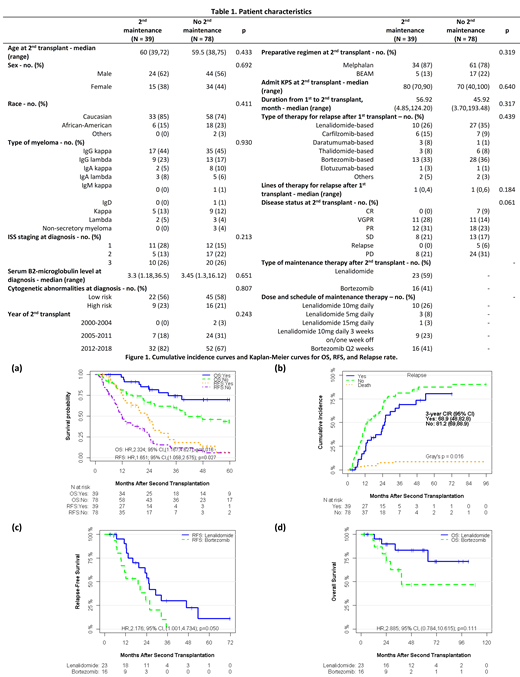Introduction: Low dose lenalidomide as a maintenance therapy after the first autologous transplant (autoSCT) has been shown to improve progression free survival (PFS) and possibly overall survival (OS) in standard-risk multiple myeloma (MM). Proteasome inhibitor-based maintenance therapy provides an alternative to lenalidomide and offers PFS and OS advantage in high-risk MM. Most recently oral ixazomib as a maintenance therapy has been shown to reduce the risk of progression by 28%. Despite the advances in maintenance therapy after first autoSCT, no prospective or retrospective studies exist evaluating efficacy of maintenance therapy after second autoSCT. In this retrospective study, we evaluated the impact of maintenance therapy after second autoSCT.
Methods: We retrospectively evaluated clinical outcomes of adult MM patients (pts) who received maintenance therapy following second autoSCT. Lenalidomide dose up to 15mg daily and subcutaneous bortezomib 1.3mg/m2 every 2 weeks were considered maintenance therapy. The pts who received higher doses or combinational therapy as maintenance were excluded. We compared outcomes between pts who did and did not receive maintenance therapy following second autoSCT. The objectives were to determine OS, relapse-free survival (RFS), relapse rate and non-relapse mortality (NRM) with maintenance therapy following second autoSCT using Cox regression and competing risk models.
Results: Between January 2000 and December 2018, 117 pts underwent second autoSCT and met the inclusion criteria. Of these, 39 received maintenance therapy and 78 did not. Median time between first and second autoSCT was 57 months (range, 4.9-124.2) in the maintenance group and 46 months (range, 3.7-193.5) in the no-maintenance group (p=0.32). Disease status at second autoSCT was complete response (CR) (n=7, 6%), very good partial response (VGPR) (n=22, 19%), partial response (PR) (n=30, 26%), stable (n=21, 18%) and progressive disease (n=32, 27%). Melphalan-based preparative regimen was used in 87% of pts, and BEAM was used in 13% of pts. All pts successfully engrafted and median time to neutrophil and platelet engraftment was 11 and 19 days, respectively.
Maintenance therapy after second autoSCT was started at a median day of 105 (range, 62-317). Lenalidomide-based maintenance therapy was commonly used in 23 (59%) pts, and bortezomib as maintenance was used in 16 (41%) pts. Sixteen pts received maintenance therapy after both first and second autoSCT, and 23 received second maintenance only. Median duration of second maintenance therapy was 16 months (range, 8.7-26.5). The best response during maintenance was CR (n=8, 21%), VGPR (n=20, 51%), PR (n=9, 23%), and stable disease (n=2, 5%). Median follow-up for OS was 48 and 60 months in the maintenance and no-maintenance group, respectively. Median OS was not reached in the maintenance group and was 40.8 months in the no-maintenance group (HR 2.32, p=0.02). At 3-year, maintenance group had superior RFS (18% vs 12%; HR 1.65, p=0.03), lower relapse rate (69 vs 81%; SHR 0.58, p=0.02). Median time to progression was 24 months in the maintenance group and 14 months in the no-maintenance group (p=0.04). Although limited by small numbers, we did not observe any impact of cytogenetics at diagnosis on OS and RFS after second autoSCT. RFS was superior with lenalidomide-based maintenance compared to bortezomib-based maintenance (HR 2.17, p=0.05). However, OS was not different. The multivariable analysis revealed that maintenance after second autoSCT was associated with significantly superior OS (HR 0.38, p=0.01), RFS (HR 0.59, p=0.03) and lower relapse rate (SHR 0.63, p=0.04). The common reasons for maintenance therapy discontinuation were disease progression (n=20, 51%), side effects (n=7, 18%), and unknown (n=12, 31%). A total of 10/39 pts who received maintenance therapy and 44/77 pts who did not receive maintenance have died.
Conclusion: This is the first study showing efficacy of maintenance therapy after second autoSCT. Maintenance therapy after second autoSCT significantly improved overall and relapsed-free survival and should be considered in all pts after second transplant. Our study also reveals real world practice pattern of using variable dose of maintenance therapy among physicians.
Deol:Novartis: Other: Advisory board; Kite: Other: Advisory board; Agios: Other: Advisory board.
Author notes
Asterisk with author names denotes non-ASH members.


This feature is available to Subscribers Only
Sign In or Create an Account Close Modal